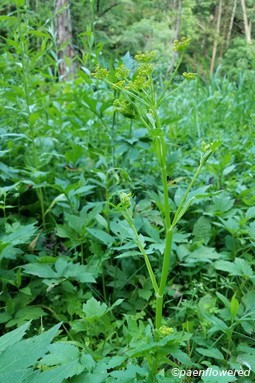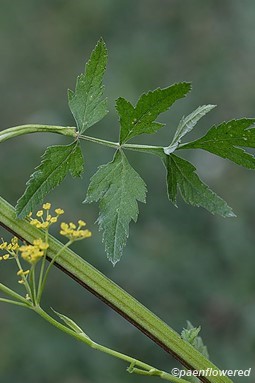Pastinaca sativa
A commong European plant found along roadsides
Pastinaca sativa wild parsnip
This plant is a native of Europe and Asia and was brought to America as a food crop by early settlers. It is a member of the carrot family. Although not a popular food today, the plant has escaped cultivation and has become a noxious and aggressive weed throughout the United States, except for the southeast.
It is a large plant, growing to a height of 2 to 5 feet, and is common on roadsides, pastures, and fields. It has alternate leaves that are pinnately compound with 5-15 leaflets. These are smaller on the upper part of the stem. The leaflets are toothed. The stem is stout, hollow, and deeply grooved.
The flower head is an umbel, a flat cluster of small flowers. In this species, the umbel can be up to six inches in diameter and is divided into sections with 12-35 flowers each. Each of these flowers is about 1/8 inch in diameter and deep yellow in color. They have five petals and a greenish-yellow nectar pad. The petals initially curl inwards but open up later.
The long taproots of the plant are edible, but the foliage is dangerous. Some people develop a severe burn-like rash if their skin contacts this plant in the presence of sunlight. A chemical in the plant called furanucoumarin is photosensitive and causes this reaction. This weed can be difficult to eradicate. It is best pulled up by the roots, but only with proper protection for the skin. Herbicides can also be used to good effect.
Habitat & Range
Grows along roadsides, woods edges, fields, meadows, and waste grounds.
Present throughout the state.
Wetland code: Not classified
Phenology
Flowers June to late July.
Characteristics
Flowers yellow, without sepals, umbels with 15 to 25 rays
Leaves compound, leaflets oblong to ovate, toothed and lobed
Fruit broadly elliptical to obovate













Comments
Have you spotted this plant in your area? We'd love to hear about your experience! Share your comments or questions about the plant below. Comments are moderated before posting.